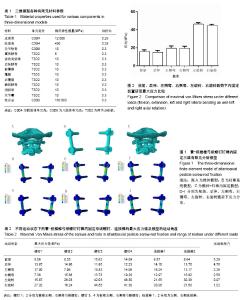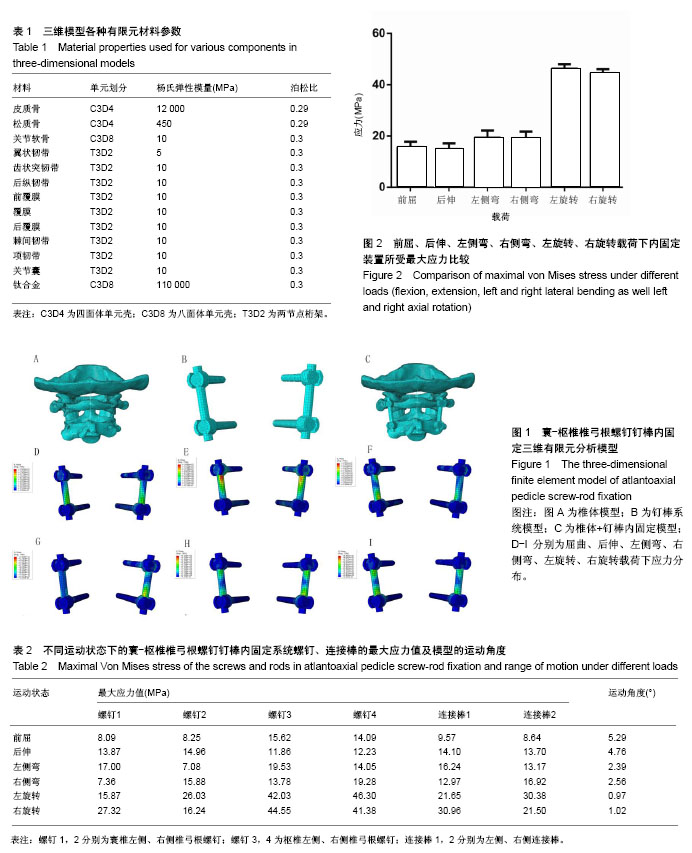| [1] 刘景堂,唐天驷,刘兴炎,等.两种长度的颈椎椎弓根螺钉与侧块螺钉拔出试验比较[J].中国脊柱脊髓杂志,2005,15(3):177-179. [2] 马向阳,尹庆水,吴增晖,等.枢椎椎板螺钉与椎弓根螺钉抗拔出强度的比较[J].中国脊柱脊髓杂志,2007,17(2):137-139. [3] 尹东,刘斌,王巧民,等.寰枢椎不稳后路椎弓根螺钉固定的三维有限元分析[J].中国临床解剖学杂志,2008,26(5):539-542. [4] Cai XH,Liu ZC,Yu Y,et al.Evaluation of biomechanical properties of anterior atlantoaxial transarticular locking plate system using three-dimensional finite element analysis. Eur Spine J. 2013;22(12):2686-2694. [5] Zhang BC,Liu HB,Cai XH,et al.Biomechanical comparison of a novel transoral atlantoaxial anchored cage with established fixation technique-a finite element analysis. Bmc Musculoskeletal Disorders. 2015;16(1):1-11.[6] 马向阳,钟世镇,刘景发,等.寰椎椎弓根螺钉进钉点的解剖定位研究[J].中国骨与关节损伤杂志,2003,18(10):683-685. [7] 马向阳,尹庆水,吴增晖,等.枢椎椎弓根螺钉进钉点的解剖定位研究[J].中华外科杂志, 2006,44(8):562-564. [8] Brolin K,Halldin P.Development of a finite element model of the upper cervical spine and a parameter study of ligament characteristics.Spine. 2004;29(4):376-385. [9] Lapsiwala SB,Anderson PA,Oza A,et al.Biomechanical comparison of four C1 to C2 rigid fixative techniques: anterior transarticular, posterior transarticular, C1 to C2 pedicle, and C1 to C2 intralaminar screws.Neurosurgery. 2006;58(3): 516-521. [10] Goel A.C1-C2 pedicle screw fixation with rigid cantilever beam construct:case report and technical note. Neurosurgery. 2002;50(2):426-428. [11] Goel A,Laheri V.Plate and screw fixation for atlanto-axial subluxation. Acta Neurochirurgica. 1994;129(129):47-53. [12] Zarro CM,Ludwig S C,Hsieh AH,et al.Biomechanical comparison of the pullout strengths of C1 lateral mass screws and C1 posterior arch screws. Spine J. 2013;13(12): 1892-1896. [13] Fensky F,Kueny RA,Sellenschloh K,et al.Biomechanical advantage of C1 pedicle screws over C1 lateral mass screws: a cadaveric study. Eur Spine J. 2014;23(4):724-731. [14] Brekelmans WA,Poort HW,Slooff T J.A new method to analyse the mechanical behaviour of skeletal parts.Acta Orthopaedica Scandinavica. 1972;43(5):301-317.[15] Rybicki EF,Simonen FA,Jr EBW.On the mathematical analysis of stress in the human femur.J Biomech. 1972; 5(2):203-215.[16] Kleinberger M. Application of finite element techniques to the study of cervical spine mechanics[C]// Stapp Car Crash Conference, 37th, 1993, San Antonio, Texas, USA. 1993.[17] Puttlitz CM,Goel VK,Traynelis VC,et al.A finite element investigation of upper cervical instrumentation.Spine. 2001; 26(22):2449-2455.[18] Shen K, Deng Z, Yang J, et al. Biomechanical study of novel unilateral C1 posterior arch screws and C2 laminar screws combined with an ipsilateral crossed C1-C2 pedicle screw-rod fixation for atlantoaxial instability.Arch Orthop Trauma Surg. 2017;137(10):1349-1355. [19] I?ik HS, Sandal E, Ça?li S. Clinical Outcomes of Posterior C1 and C2 Screw-Rod Fixation for Atlantoaxial Instability.Turk Neurosurg. 2017. doi: 10.5137/1019-5149.JTN.20525-17.1.[20] Darwazeh R, Liu Q, Deng L, X, et al. Surgical Intervention for Unstable Craniovertebral Junction Anomalies with Narrow C2 Pedicle.World Neurosurg. 2017;103:647-654.[21] Matsumoto Y, Mizutani J, Suzuki N, et al. Temporary Internal Fixation Using C1 Lateral Mass Screw and C2 Pedicle Screw (Goel-Harms Technique) without Bone Grafting for Chronic Atlantoaxial Rotatory Fixation.World Neurosurg. 2017;102: 696.e1-696.e6.[22] Ni B, Zhao W, Guo Q, et al. Comparison of Outcomes Between C1-C2 Screw-Hook Fixation and C1-C2 Screw-Rod Fixation for Treating Reducible Atlantoaxial Dislocation.Spine (Phila Pa 1976). 2017;42(20):1587-1593.[23] Rajinda P, Towiwat S, Chirappapha P. Comparison of outcomes after atlantoaxial fusion with C1 lateral mass-C2 pedicle screws and C1-C2 transarticular screws.Eur Spine J. 2017;26(4):1064-1072. [24] Nakao Y, Shimokawa N, Morisako H, et al. Late complication of surgically treated atlantoaxial instability: occipital bone erosion induced by protruded fixed titanium rod: a case report.J Chiropr Med. 2014;13(4):278-281. [25] Kim JY, Oh CH, Yoon SH, et al. Comparison of outcomes after atlantoaxial fusion with transarticular screws and screw-rod constructs.J Korean Neurosurg Soc. 2014;55(5):255-260. [26] Chen B, Teng HL, Dai YS, et al. [Clinical application of unilateral axis translaminar screws in upper cervical instability with vertebral artery variations].Zhongguo Gu Shang. 2014; 27(2):101-105.[27] Bhowmick DA, Benzel EC. Posterior atlantoaxial fixation with screw-rod constructs: safety, advantages, and shortcomings.World Neurosurg. 2014;81(2):288-289. [28] Jeon SW, Jeong JH, Choi GH, et al. Clinical outcome of posterior fixation of the C1 lateral mass and C2 pedicle by polyaxial screw and rod. Clin Neurol Neurosurg. 2012;114(6): 539-544. [29] Lee SH, Kim ES, Sung JK, et al. Clinical and radiological comparison of treatment of atlantoaxial instability by posterior C1-C2 transarticular screw fixation or C1 lateral mass-C2 pedicle screw fixation.J Clin Neurosci. 2010;17(7):886-892. [30] Desai R, Stevenson CB, Crawford AH, et al. C-1 lateral mass screw fixation in children with atlantoaxial instability: case series and technical report.J Spinal Disord Tech. 2010;23(7): 474-479. [31] Yang YJ, Zhang EZ, Tan YC, et al. Clinical application of atlantoaxial pedicle screw internal fixation for treatment of atlantoaxial dislocation. Zhongguo Gu Shang. 2009;22(11): 832-834. |

